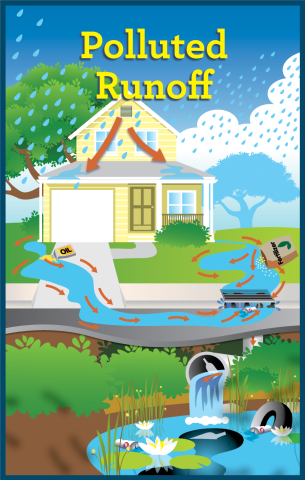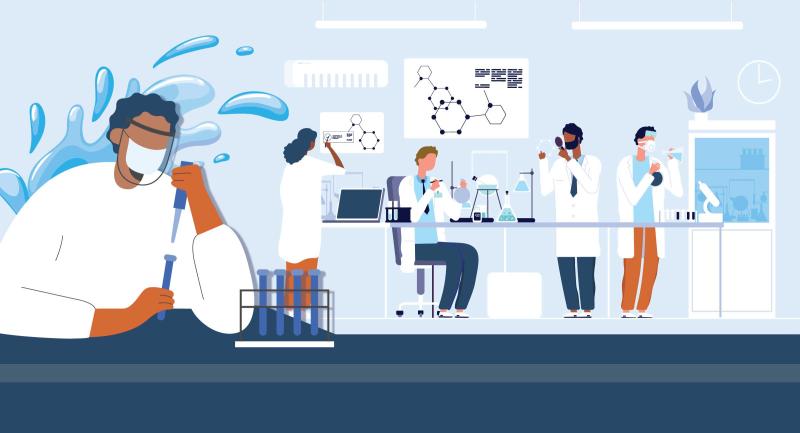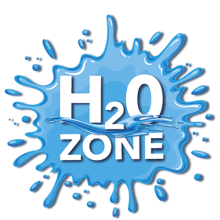What Is Stormwater Runoff?

In Florida, stormwater runoff occurs during or after a rainfall event. Stormwater from the rain flows over impervious, or hard, surfaces like driveways, sidewalks, streets, parking lots and roofs, where it is unable to percolate (filter or seep) into the ground. This unfiltered water then reaches our neighborhood streams, ponds, lakes, bays, wetlands and oceans. It can even make its way into our groundwater.
Why Is Stormwater Runoff a Problem?
Stormwater runoff can collect many different types of pollution before it reaches a body of water, including debris, dirt and chemicals. The stormwater collects these materials like a magnet and carries them directly into a body of water like a stream or lake. These water bodies may be used for recreational activities, such as swimming, fishing or kayaking, and may even provide some of us with drinking water! A variety of plants and wildlife also depend on these water bodies to survive.
What Type of Pollution is Stormwater Runoff?
There are two basic types of pollution: point source and non-point source. Point source pollution is easy to understand because it can be traced directly to its source. Think of it like this: if a sewage plant has a broken pipeline that leaks raw sewage into a river, you can "point" your finger at the exact source of the pollution. Point source pollution was a big concern in the past, but today stricter laws and regulations have drastically decreased the problem.
Non-point source pollution is a little more difficult to understand. Pollution from stormwater runoff is a type of non-point source pollution. This means that the pollution cannot be traced back to a specific source, but instead comes from many different sources throughout the watershed. Non-point source pollution is the primary cause of watershed pollution today. Non-point source pollution occurs when a small amount of pollution from a large variety of sources is picked up by stormwater runoff and carried into water bodies. You can't point to the specific origin of the contamination; it comes from too many places and is difficult to trace.
How Do Different Types of Pollution Affect My Watershed?
Stormwater runoff can carry many different types of non-point source pollution. Each can affect your watershed in a different way. Learn about some common pollutants that contribute to stormwater runoff below.
- Sediment (dirt, soil, sand) can increase the turbidity (a measure of water cloudiness) of a water body. Turbidity can block sunlight from reaching aquatic plants, making it impossible for them to grow. Without plants, animals lose a food source and it is more difficult to filter pollutants from the water. Instead, pollutants collect in the bottom of the water body and remain there indefinitely.
- Excess nutrients carried in stormwater runoff can also negatively affect our water supply. These nutrients, primarily nitrogen and phosphorus, can come from lawn fertilizers or natural sources, such as manure. Nutrients can cause algal and bacterial blooms, which reproduce rapidly. Algae consumes oxygen, increases turbidity in the water body and eventually dies along with the fish and other aquatic life that need oxygen to live.
- Pathogenic bacteria and other pathogenic microorganisms can be carried by stormwater into a water body. Pathogenic means to be capable of causing disease, especially in humans. When pathogenic bacteria or microorganisms enter a water body, this creates health hazards and can cause lakes and beaches to close.
- Debris such as plastic bags, bottles and cigarette butts can wash into a water body and interfere with aquatic life. It also isn't very pretty.
- Various hazardous wastes can be carried into a water body. These include insecticides (chemicals used to control or kill insects), herbicides (chemicals used to kill unwanted plants), paint, motor oil and heavy metals. All of these items can cause illness not only to aquatic life, but also to humans.
REMEMBER: All of these pollutants can make it into our drinking water through the water cycle. Although our drinking water is treated before it makes it to our faucet, it is still important to protect it from harmful pollutants.
Water quality monitoring is a means to protect our drinking water. Learn more on the next page.


